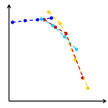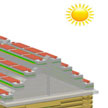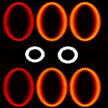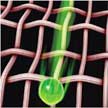Showing Spotlights 1025 - 1032 of 2876 in category All (newest first):
 In the fields of toxicology and ecotoxicology, doses are commonly expressed in weight concentration for non-soluble compounds because this is very convenient experimentally. However, when it comes to nanoparticles, the weight of the nanomaterial is not a relevant parameter, especially when it is required to compare different kinds of nanoparticles because their density is very different. Researchers have now shown that the usual approach based on mass concentrations fails to compare the toxicities of different engineered carbon nanoparticles.
In the fields of toxicology and ecotoxicology, doses are commonly expressed in weight concentration for non-soluble compounds because this is very convenient experimentally. However, when it comes to nanoparticles, the weight of the nanomaterial is not a relevant parameter, especially when it is required to compare different kinds of nanoparticles because their density is very different. Researchers have now shown that the usual approach based on mass concentrations fails to compare the toxicities of different engineered carbon nanoparticles.
May 24th, 2016
 Self-powered nanotechnology based on these nanogenerators aims at powering nanodevices and nanosystems using the energy harvested from the environment in which these systems are suppose to operate. An interesting approach comes from a group of Chinese scientists who propose to scavenge the large amounts of wasted wind energy in cities: they propose hybridized nanogenerator that consists of a solar cell and a triboelectric nanogenerator, which can be utilized to individually or simultaneously scavenge solar and wind energies.
Self-powered nanotechnology based on these nanogenerators aims at powering nanodevices and nanosystems using the energy harvested from the environment in which these systems are suppose to operate. An interesting approach comes from a group of Chinese scientists who propose to scavenge the large amounts of wasted wind energy in cities: they propose hybridized nanogenerator that consists of a solar cell and a triboelectric nanogenerator, which can be utilized to individually or simultaneously scavenge solar and wind energies.
May 23rd, 2016
 High-temperature heaters, such as furnaces, are widely used in chemical reactions, materials synthesis and device processing. The limitations of these heating devices often are their bulky size, weight, low maximum heating temperatures and slow ramp rates. To overcome these limitations, and to provide a heating element with a high temperature range to the target object in a micro- and nanoscale environment, researchers have developed a 3D-printable high-temperature, high-rate heater that can be applied to a wide range of nanomanufacturing when precise temperature control in time, placement, and the ramping rate is important.
High-temperature heaters, such as furnaces, are widely used in chemical reactions, materials synthesis and device processing. The limitations of these heating devices often are their bulky size, weight, low maximum heating temperatures and slow ramp rates. To overcome these limitations, and to provide a heating element with a high temperature range to the target object in a micro- and nanoscale environment, researchers have developed a 3D-printable high-temperature, high-rate heater that can be applied to a wide range of nanomanufacturing when precise temperature control in time, placement, and the ramping rate is important.
May 19th, 2016
 When inkjet printing graphene, achieving satisfactory results it is a trade-off between the sizes of the graphene sheets and the chosen printing strategies. Direct ink writing offers an attractive way to break the routine and meet the printability with the demanding sheet sizes. The nozzles' diameters range from sub micrometer to millimeter scale to accommodate the inks. More importantly, the extrusion-based procedure plays a crucial role in directing the orientation of graphene sheets to pass through the nozzle during printing.
When inkjet printing graphene, achieving satisfactory results it is a trade-off between the sizes of the graphene sheets and the chosen printing strategies. Direct ink writing offers an attractive way to break the routine and meet the printability with the demanding sheet sizes. The nozzles' diameters range from sub micrometer to millimeter scale to accommodate the inks. More importantly, the extrusion-based procedure plays a crucial role in directing the orientation of graphene sheets to pass through the nozzle during printing.
May 12th, 2016
 Quantum computation using artificial-atoms can be sensitively controlled by external electromagnetic fields. These fields and the self-fields attributable to the coupled artificial-atoms influence the amount of quantum correlation in the system. However, control elements that can operate without complete destruction of the entanglement of the quantum-bits are difficult to engineer. In new work, scientists have investigate the possibility of using closely spaced-linear arrays of metallic-elliptical discs as whispering gallery waveguides to control artificial atoms.
Quantum computation using artificial-atoms can be sensitively controlled by external electromagnetic fields. These fields and the self-fields attributable to the coupled artificial-atoms influence the amount of quantum correlation in the system. However, control elements that can operate without complete destruction of the entanglement of the quantum-bits are difficult to engineer. In new work, scientists have investigate the possibility of using closely spaced-linear arrays of metallic-elliptical discs as whispering gallery waveguides to control artificial atoms.
May 10th, 2016
 Superhydrophobic surfaces that can also withstand mechanical deformation such as bending and stretching are important for applications such as robust self-cleaning, water-resistant electronics, and flexible microfluidics. Researchers have now reported the design of 3D hierarchical wrinkle substrates that can maintain their superhydrophobicity even after being repeatedly stretched. This is made possible by using monolithic, multi-scale PDMS nanowrinkles that can exhibit stretchable superhydrophobicity using high fidelity pattern transfer.
Superhydrophobic surfaces that can also withstand mechanical deformation such as bending and stretching are important for applications such as robust self-cleaning, water-resistant electronics, and flexible microfluidics. Researchers have now reported the design of 3D hierarchical wrinkle substrates that can maintain their superhydrophobicity even after being repeatedly stretched. This is made possible by using monolithic, multi-scale PDMS nanowrinkles that can exhibit stretchable superhydrophobicity using high fidelity pattern transfer.
May 5th, 2016
 MoS2 nanosheets have shown great prospect as a near-infrared light (NIR) absorbing agent for PTT applications due to their unique photoelectric property, low cost and good biocompatibility. However, the absorbance of nanosheets in the NIR region is not specific and strong, and the photothermal conversion efficiency of MoS2 based materials need to be enhanced. In new work, researchers have proposed a novel MoS2 nanostructure, i.e. layered MoS2 hollow spheres (LMHSs), for improving their near-infrared absorption and photothermal conversion efficiency.
MoS2 nanosheets have shown great prospect as a near-infrared light (NIR) absorbing agent for PTT applications due to their unique photoelectric property, low cost and good biocompatibility. However, the absorbance of nanosheets in the NIR region is not specific and strong, and the photothermal conversion efficiency of MoS2 based materials need to be enhanced. In new work, researchers have proposed a novel MoS2 nanostructure, i.e. layered MoS2 hollow spheres (LMHSs), for improving their near-infrared absorption and photothermal conversion efficiency.
Apr 28th, 2016
 Today, the best performing battery in terms of specific energy and specific power is the secondary lithium-metal (Li-metal). However, uncontrolled dendrite growth during Li depositing/stripping in rechargeable Li metal based batteries has prevented their practical applications over the past 40 years. To address this issue, researchers have now proposed a novel method of modulating the lithium ion adsorption to suppress lithium dendrite growth by employing glass fiber as solid electrolytes with plenty of polar functional groups as the interlayer between Li metal anode and routine polymer separator.
Today, the best performing battery in terms of specific energy and specific power is the secondary lithium-metal (Li-metal). However, uncontrolled dendrite growth during Li depositing/stripping in rechargeable Li metal based batteries has prevented their practical applications over the past 40 years. To address this issue, researchers have now proposed a novel method of modulating the lithium ion adsorption to suppress lithium dendrite growth by employing glass fiber as solid electrolytes with plenty of polar functional groups as the interlayer between Li metal anode and routine polymer separator.
Apr 19th, 2016
 In the fields of toxicology and ecotoxicology, doses are commonly expressed in weight concentration for non-soluble compounds because this is very convenient experimentally. However, when it comes to nanoparticles, the weight of the nanomaterial is not a relevant parameter, especially when it is required to compare different kinds of nanoparticles because their density is very different. Researchers have now shown that the usual approach based on mass concentrations fails to compare the toxicities of different engineered carbon nanoparticles.
In the fields of toxicology and ecotoxicology, doses are commonly expressed in weight concentration for non-soluble compounds because this is very convenient experimentally. However, when it comes to nanoparticles, the weight of the nanomaterial is not a relevant parameter, especially when it is required to compare different kinds of nanoparticles because their density is very different. Researchers have now shown that the usual approach based on mass concentrations fails to compare the toxicities of different engineered carbon nanoparticles.
 Subscribe to our Nanotechnology Spotlight feed
Subscribe to our Nanotechnology Spotlight feed





